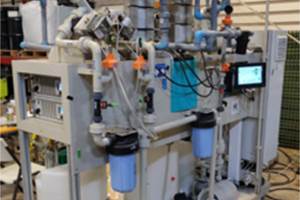Cleaning Expanded Stainless
We’re looking to install an in-line (or off-line) cleaning system that would degrease flat expanded metal sheet made out of 0.015-inch-thick SS T409 material.
Q. I’d like to consult you regarding our cleaning needs for expanded metal coils. We’re looking to install an in-line (or off-line) cleaning system that would degrease flat expanded metal sheet made out of 0.015-inch-thick SS T409 material. The slit width is 13 inches but we would like the equipment to accept up to 24-inch-slit width and handle from 30–15 gauge stainless steel. I think it would be two-stage equipment where in stage one, you wash the part and stage two you dry it. We have available space in-line (approx. 4 × 4 ft) where it could fit, but if equipment is too large, we can put it off-line.
The expanded metal mesh is very fine (0.083 × 0.142 inches) and our customer wants the lubricant to be removed. Kindly let me know if there is any standard equipment that could be used for this application. If not, who could build custom equipment for us? M.R.
A. I do not believe there is any washer manufacturer that would be able to provide a parts washer without some level of custom design. Probably the most challenging aspect of your opportunity would be the material handling aspect since you are dealing with expanded metals sheets as thin as 30 gauge, (approximately 0.012 inches or 0.3 mm). Since you mention the width, but no length, I would assume you are interested in cleaning sheet continuously with a final reel to roll up the finished and cleaned expanded metal.
I am not sure of the process lubricants used or line speed, but believe the 4 × 4-ft space will not be large enough to accommodate this as an in-line process, although it would make the most sense to do it this way. Even the width may not be possible to contain within a 4-ft distance since the desired process sheet width is 24 inches, along with material handling hardware (likely sheet guides), then spray risers, insulation, controls cabinet, etc. (I believe the controls cabinet alone needs a minimum of 36 inches clearance around it alone for OSHA regulations). I’d consider making floor accommodations for an in-line cleaning system, otherwise the additional handling for the off-line process will introduce further costs and potential to damage otherwise good finished product.
I think you need cleaning, rinsing and drying stages in this washer as well. Again, depending on the line speed, I don’t think there’s any way you could run this operation through a 4-ft space, since you need entrance and exit vestibules to the washer for exhaust, along with the three stages and quiet zones staged between the three stages. In total, this adds up to seven “sections” to the washer (entrance vestibule, wash, drain zone, rinse, drain zone, exit vestibule and dry). So unless you only have one riser in each wash and rinse stage and an extremely slow line speed, it’s unlikely to fit into this space. I suggest you consult the Supplier section of pfonline.com and look under the Cleaning and Pretreatment Equipment section.
Alternatively, I would consider using a process lubricant formulated specifically for thermal degreasing. In this process you simply evaporate the lubricant from the part using elevated temperature and recirculated air flow. In this case, proper lubricant choice is critical to the success of this process to ensure the lubricant doesn’t “char” on the metal surface. You could then use one of the same suppliers found above or an oven supplier. This would greatly simplify the process and potentially fit into your 4 × 4-ft space.
Related Content
TTX Environmental Solves Customer Issue with Electro-Ceramic Desalination Wastewater Processing
Electroplating facility without access to a drainage system found a safe solution for wastewater treatment and reuse.
Read MoreClean Technology Lasers for Coating Adhesion
Laser cleaning systems remove corrosion, grease, residue and existing coatings from metal surfaces quickly, with less preparation and mess than traditional techniques.
Read More3-Stage Versus 5-Stage Washers
Columnist Rodger Talbert explains the difference between a five-stage washer and a three-stage washer, and how one provides better corrosion protection over the other.
Read MoreRead Next
A ‘Clean’ Agenda Offers Unique Presentations in Chicago
The 2024 Parts Cleaning Conference, co-located with the International Manufacturing Technology Show, includes presentations by several speakers who are new to the conference and topics that have not been covered in past editions of this event.
Read MoreEpisode 45: An Interview with Chandler Mancuso, MacDermid Envio Solutions
Chandler Mancuso, technical director with MacDermid Envio discusses updating your wastewater treatment system and implementing materials recycling solutions to increase efficiencies, control costs and reduce environmental impact.
Read MoreEducation Bringing Cleaning to Machining
Debuting new speakers and cleaning technology content during this half-day workshop co-located with IMTS 2024.
Read More


























